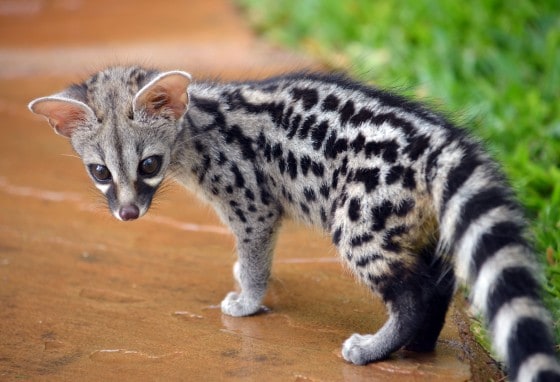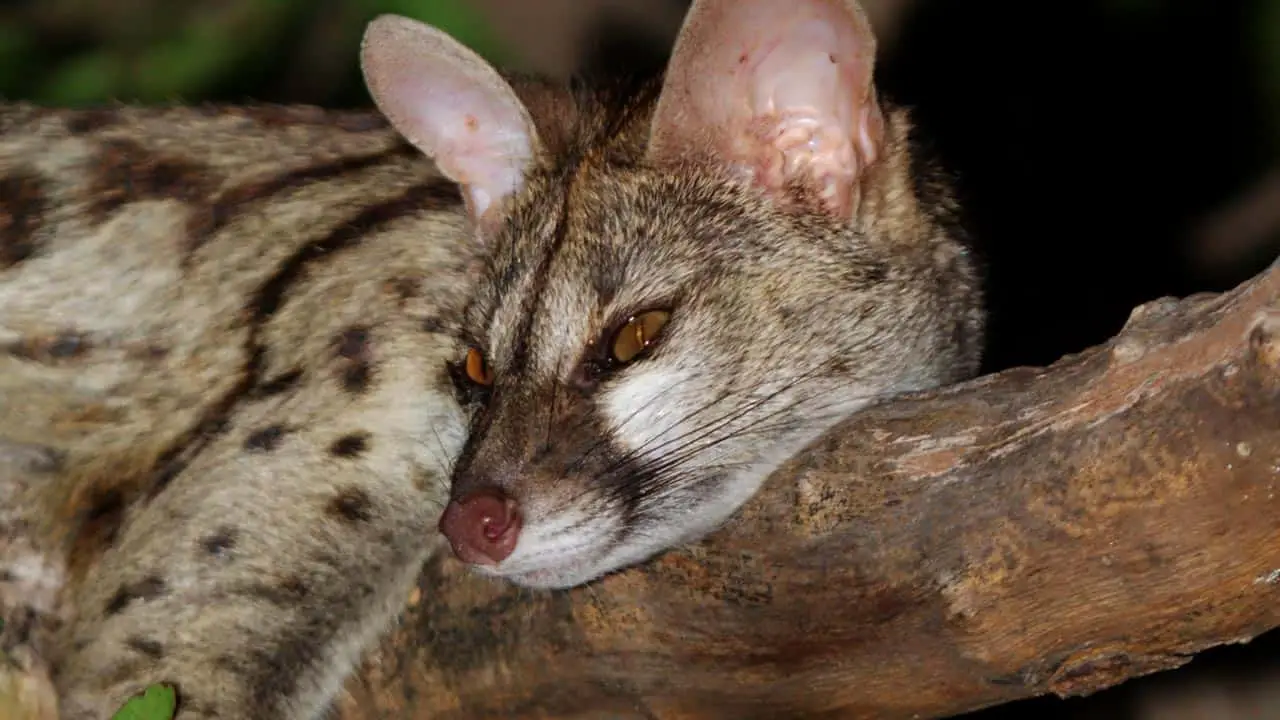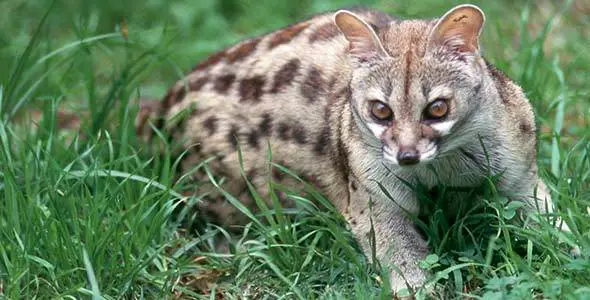Table of Contents
*This post may contain affiliate links. As an Amazon Associate we earn from qualifying purchases.
Africa is home to an incredible assortment of wild animal species, some of the most exotic and awe-inspiring in the world. Like any continent, some of the most deadliest creatures seen in the wild have their roots in Africa: lions, hippopotamuses, black mambas are among the few.
The genet is, thankfully, not among these deadly creatures. They’re even kept as pets by some exotic animal lovers.
Habitats of the Genet
Genets are not exactly rare or valuable animals, in fact they’re rather common across most of Africa. It should be noted that, although they cover a pretty good swathe of Africa, they are distinctly absent from the drier, arid regions, especially deserts.
Unlike other renowned African wildlife, the genet doesn’t find itself in danger of extinction anytime soon. They’re even common enough to be considered pests by some communities, stealing livestock and growing accustomed to living among humans. They’re a little like raccoons in that regard.
Due to their adaptation to human settlements and expansion, their occasional pest label leads to extermination. Though this retaliatory killing does not pose an existential threat to the species, there are still support advocating alternative tactics for dealing with them. After all, they’re not dangerous, just obnoxious.
While genets are native to the African continent, they have been introduced to some European regions due to historical trading efforts. Since being brought to parts of France, Portugal, and Spain among others as pets, they’ve since established their own, albeit small, populations in primarily in wooded areas, especially near rivers and creeks. While some of these populations might have been intentionally established, more often than not they’re composed of escaped pets. They’ve even found their way to Italy, independent of human efforts.
As smaller creatures, the genet prefers dense vegetation, wooded regions, and savannas. Places that include rocky enclosures provide excellent shelter, and nearby water sources like creeks lure them to valley basins.

Why These Habitats
Genets are not large creatures. They’re only around 20 inches in body length, with a tail that may be just as long if not longer. While other animals that are around the same size as a genet make up for a lack in stature with fierceness and natural defenses, genets are not known for their abilities to defend themselves.
A genet is a natural tree climber, and will often use that to their advantage to either escape from predators or hunt down prey of their own. Their tails provide excellent balance for them to leap from tree to tree, and otherwise would not have much of a use in areas with less foliage. This is the same reason why you won’t find them in the Sahara, but will find them in the wooded region just north of it.
The more cover a genet can find the better. Caves and trees, yes, but plenty of dense shrubland suits them well. Since they will often find themselves living close to human civilization, they reveal themselves to be a bold animal when it comes to foraging. This boldness is what permits them to live in places with a dense human population.
While genets may occasionally find themselves sleeping in tree hollows, they’re more likely to be found taking shelter in rocky area or burrows in the ground. These are the same places they will keep their young after the gestation period is over, safely hidden from prying eyes.
The Genet’s Food Supply
Then, of course, there’s the food situation. While lions, giraffes, and zebras find more comfort in wide, open spaces to freely run and either hunt or escape from predators, genets don’t specialize in either of those areas. Mobility and naturally contained areas will more readily strike their fancy.
While commonly mistaken as carnivores, genets are actually omnivores, able and willing to eat anything they come in contact with. Genets will primarily feed on small animals of any variety they can find: mammals, lizards, bats, the whole spectrum as long as it can fit in their mouths. Fruit, on the other hand, are a lot easier to hunt, and if given the opportunity they will feed on any manner of fruit, mushrooms, and even garbage. Given the choice, however, they’re more likely to aim for the living, breathing morsel.
If there’s one thing that defines the genet, it’s that it’s an opportunist. They’ll take food from wherever it’s available, in most any form, and won’t complain about it. Once again, this opportunistic mindset is what allows such adaptation to human settlements. Their boldness, appearance, and general behavior is likely what made them targets for semi-domestication in the first place.

Genet Hunting Characteristics
Genets are especially exceptional with their maneuverability and agile bodies. They, unlike other viverrids, are the only ones of their family capable of standing on their hind legs. While that may not be the most instrumental aspect of hunting, it does help them reach challenging places to retrieve eggs from trees or to root through human trash.
Due to their talents with tree climbing, much of their hunting will happen in the canopy. Birds, and their subsequent offspring, will often fall prey to scouring genets. Any tree dwelling animals, in general, are going to be on the genet’s radar. While they are often arboreal creatures, and spend much of their time in the trees, they in fact live on the ground and do spend time hunting there as well.
Genets, while primarily nocturnal, are generally more active in the immediate hours around sunset and sundown, making them a crepuscular creature. These hours make up the highest concentration of their activity, but they’re far from adverse to moving about while the moon is out. Due to this, they have excellent night vision.
Genet Living and Behavior
Genets live a solitary life away from others of their kind. The only exception to them being seen in pairs is during mating season, but otherwise they’re not likely to be found socializing. Their proclivity to singular life, then, makes them unlikely to get along with other pets an exotic pet owner may have.
As a pet, it should be noted that, like most any beanimal, they are not truly domesticated like a dog or cat is. While they exhibit many behavioral characteristics shared with cats or ferrets. They’re not especially cuddly, and due to the nature of their flexible bodies, they’re often escape artists. If there is an opening large enough for a genet to fit their head through, they will be able to move their entire body through it. It’s likely because of this body-type that they were able to populate the European regions.
It’s a body type that aids them well in their native environments, creating a versatile skill set that directly benefits their survival. They have a musk gland near their anus that provides them with a litany of special purposes. For communication, this gland may provide sexual or social cues for nearby genets, particularly useful for mating season. Most importantly for their environment, however, it’s used to mark their territory. Plus, if threatened, they can spray a noxious excretion, much like a skunk.
Genet Summaration
Genets are native to Africa, in three distinct swathes across the continent. They can be found in the northern region above the Sahara, a large, coast-to-coast strip from Senegal to Tanzania, and most of South Africa. Since being brought by humans to other parts of the world around 1000 years ago, they’ve established new populations in several European countries.
If you’re looking to find a genet, you’ll do best looking in deciduous and evergreen areas with plenty of foliage, dense shrubland, and some rocky areas. They’re most active at night, and during the day prefer to sleep in enclosed spaces like tree hollows or burrows in the ground. They’re largely independent creatures with fairly bold personalities when it comes to obtaining food.
They’re fascinating animals, and can make surprisingly decent pets if you had the proclivity to the kinds of challenges they present. They can have a bit of an appetite, willing to eat about anything edible put in front of them, and are incredibly agile creatures.
You’ll probably have to look up a lot to find them, though.

